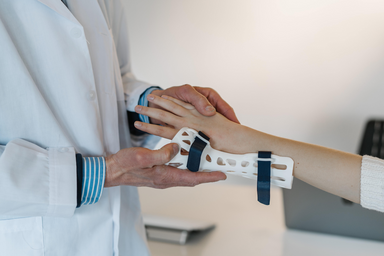About a few weeks before the end of winter break, I was doing yoga and hurt my right wrist. I thought it was a small strain and didn’t really think much of it. However, the pain worsened as I kept working out and using it, and a weird tingly feeling began to spread to my left wrist. Little did I know that this weird numb tingly sensation was serious foreshadowing for the worst to come.
After using my wrists normally once I returned back to school, the pain came back. During the first week of school, with assignments slowly picking up and overall more work to do, my wrists totally gave out on me. I remember sitting in front of my laptop wincing as I typed because my entire forearm and fingers felt numb. I kept telling myself it was only a sprain and that it would go away, which was a big mistake. Fast forward to the next day, and I genuinely could not use both of my arms or hands at all. I know it sounds really dramatic, but my fingers swelled to the size of sausages, and I genuinely couldn’t use any force before wincing in pain. I finally decided to see my doctor that day, who confirmed that I indeed had a severe case of carpal tunnel syndrome (CTS). Remember that slight tingly feeling in my wrist that I mentioned earlier from winter break? Yeah, that was a telltale sign that I completely ignored. I was in shock, mostly because I thought CTS was something only middle aged people got, but it turns out that this condition is pretty common among office workers and students.
In short, CTS or “median nerve compression” is a condition that causes numbness, tingling, or weakness in your hand(s). While there is no single cause for CTS, there are some risks that could increase one’s chances of getting it; these include, but are not limited to: sex (women who have small carpal tunnels have a higher chance of developing the condition), work environment (people who work computer/keyboard heavy jobs), and preexisting medical conditions. Unfortunately for me, I fall under two of the categories on that list. I have small frail wrists, and I spent close to 70% of my days in front of a computer. I also learned that I had horrible typing posture, which I soon worked to fix.
My overall experience with CTS can be boiled down to one word: awful. I honestly felt like I took my wrists for granted all these years because for about two full weeks, my arms and hands were basically immobile. Thankfully, I had my boyfriend to help me with chores and everyday activities like cooking and cleaning, but that feeling of being injured and useless made me feel so antsy. I also fell completely behind on schoolwork and extracurricular activities (like Her Campus). However, with the help of a few lifestyle changes, painkillers, and wearing a wrist brace on each of my hands, I slowly started to recover around week three. I know this is a pretty niche topic, but I wanted to bring some awareness to it and emphasize the importance of good wrist hygiene.
To overcome CTS, I’d recommend getting wrist braces to keep your hands relaxed and in place. I got one for both my left and right wrists and started wearing them everyday until I was no longer in pain. Now I only put them on at night to keep my wrists in place while I sleep, but these seriously made a huge difference. To fix my horrible typing posture, I got a monitor, external keyboard, and a wrist rest. My new computer set-up is honestly a game changer. The wrist rest helps keep my hands resting at the keyboard and not hovering over it like they used to. A monitor also made me so much more productive with all the screen real estate it provides. Overall, these investments were so worth it.

Mentally, my advice would be to allow yourself to rest. As someone who likes to constantly go, go, go, I know how hard simply sitting still and relaxing can be. However, the silver lining was that I actually had a lot of free time to read when my CTS was at its peak. I also learned to stop Googling the condition; not everyone has the same experience. I know that some people end up getting surgery to fix the numbness, but there are also many others who have fully recovered. This information is still something that I have to remind myself of. Finally, my last tip is to simply be patient. I had to definitely learn this the hard way; I kept thinking I was able to carry more, text, write, etc. everyday, but after many painful failures, I’ve learned to just take it easy day by day. The road to recovery for CTS is a long one – with no specific timeline – but I’ve slowly and successfully started to gain control over my wrists again.
To prevent developing CTS, it’s important to practice good typing posture. For reference, your palms should be resting on a hard surface (like the empty space surrounding the trackpad on a laptop or the table while using a desktop computer) while typing. Using your laptop in bed leaned against the wall with your hands curled to type is one of the worst postures to have (trust me, I used to do this all the time). Another tip I have is to do wrist stretches. We stretch other parts of our body when we workout, but we often neglect our wrists. I used to do a lot of yoga and pilates, putting significant strain on my wrists, and I would rarely stretch this out. Despite having CTS or not, stretching is a great preventative measure. Check out this website to learn some wrist stretches.

While CTS served as a major obstacle for me this semester, I am on the road to recovery and way more observant about when my body needs a break now. I hope my experience and tips helped you become more aware of your wrists in addition to some ways to take better care of them!



